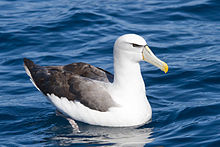水鳥類
外观
| 水鸟类 | |
|---|---|

| |
| 白頂信天翁(Thalassarche cauta) | |
| 科学分类 | |
| 界: | 动物界 Animalia |
| 门: | 脊索动物门 Chordata |
| 纲: | 鸟纲 Aves |
| 演化支: | 今颚类 Neognathae |
| 演化支: | 新鸟类 Neoaves |
| 演化支: | 雀类 Passerea |
| 演化支: | 水滨鸟类 Aequorlitornithes |
| 演化支: | 鹭形类 Ardeae |
| 演化支: | 水鸟类 Aequornithes Mayr, 2010 |
| 演化支 | |
水鳥類(學名:Aequornithes)是一個被定义为“包含潛鳥科(Gaviidae)和鸕鷀科(Phalacrocoracidae)的最小演化支”。[1][2]
分類
[编辑]该群的单系性目前得到了几个分子系统发育研究的支持。[3][4][5][6]
系統發生學
[编辑]本演化支包括了潛鳥目、企鵝目、鹱形目、鸛形目、鰹鳥目和鵜形目。但一些水鸟群体如火烈鸟目、鷿鷈目、鴴形目及雁形目等則不包括在內。
根据鸟类各目的全基因组分析,日鳽目和鸏形目所組成的日鳽總目是本演化支最親近的姐妹群,共同組成鷺形類。[1]
本類群與其它水濱鳥類的演化關係如下:
| 水濱鳥類 |
| ||||||||||||||||||||||||||||||
| Aequorlitornithes |
本類群內部主要各支演化關係如下:
| 水鳥類 |
| ||||||||||||||||||||||||
| Aequornithes |
參考文獻
[编辑]- ^ 1.0 1.1 Jarvis, E.D.; et al. Whole-genome analyses resolve early branches in the tree of life of modern birds. Science. 12 December 2014, 346 (6215): 1320–1331. Bibcode:2014Sci...346.1320J. PMC 4405904
 . PMID 25504713. doi:10.1126/science.1253451.
. PMID 25504713. doi:10.1126/science.1253451.
- ^ Mayr, G. Metaves, Mirandornithes, Strisores and other novelties – a critical review of the higher-level phylogeny of neornithine birds. J Zool Syst Evol Res. February 2011, 49 (1): 58–76. doi:10.1111/j.1439-0469.2010.00586.x.
- ^ Hackett, S.J.; et al. A Phylogenomic Study of Birds Reveals Their Evolutionary History. Science. 27 June 2008, 320 (5884): 1763–1768. Bibcode:2008Sci...320.1763H. PMID 18583609. doi:10.1126/science.1157704.
- ^ Yuri, T.; et al. Parsimony and model-based analyses of indels in avian nuclear genes reveal congruent and incongruent phylogenetic signals. Biology. 2013, 2 (1): 419–444. PMC 4009869
 . PMID 24832669. doi:10.3390/biology2010419.
. PMID 24832669. doi:10.3390/biology2010419.
- ^ Kimball, R.T.; et al. Identifying localized biases in large datasets: A case study using the Avian Tree of Life. Mol Phylogenet Evol. December 2013, 69 (3): 1021–32 [2019-11-23]. PMID 23791948. doi:10.1016/j.ympev.2013.05.029. (原始内容存档于2016-11-03).
- ^ Kuramoto, T. et al. (November 2015). "Determining the Position of Storks on the Phylogenetic Tree of Waterbirds by Retroposon Insertion Analysis". Genome Biology and Evolution, 7 (12):3180–3189. doi:10.1093/gbe/evv213 PDF fulltext.
